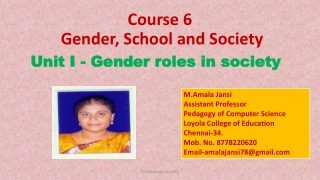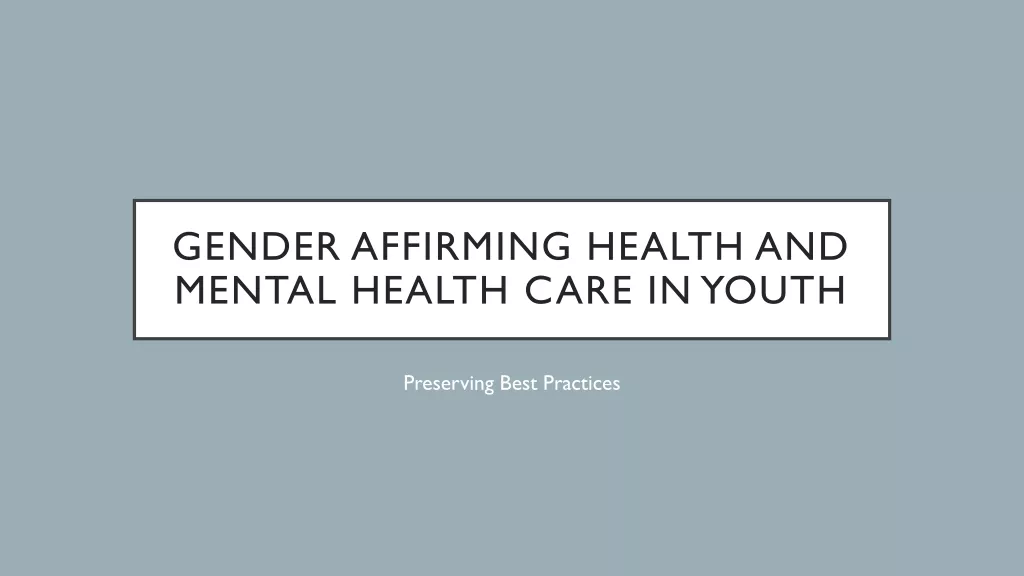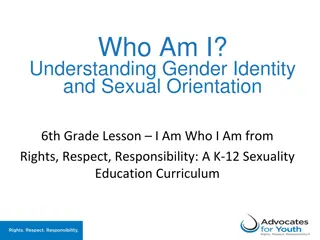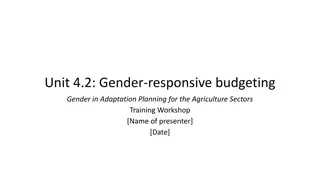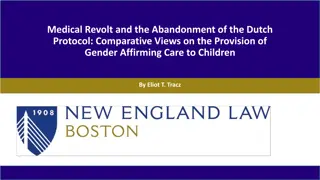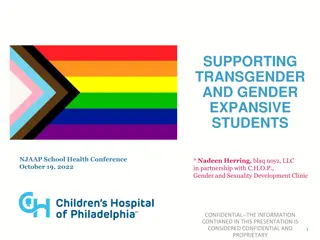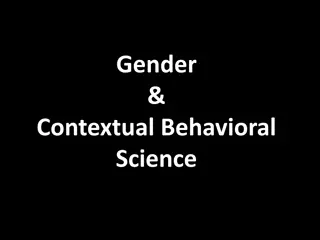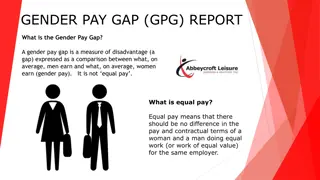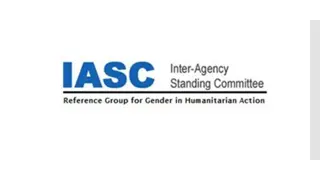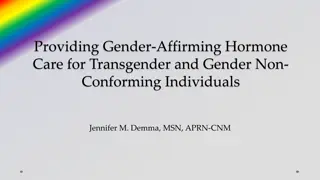Understanding Gender Dysphoria: Diagnosis and Management
Gender dysphoria, previously known as gender identity disorder, refers to persistent discomfort with one's biologic sex or assigned gender. This article explores the epidemiology, diagnostic criteria, and management of gender dysphoria, highlighting prevalence rates and research findings from various regions, including Africa. Despite challenges in data availability, efforts are being made to understand and address gender dysphoria globally.
Download Presentation

Please find below an Image/Link to download the presentation.
The content on the website is provided AS IS for your information and personal use only. It may not be sold, licensed, or shared on other websites without obtaining consent from the author. Download presentation by click this link. If you encounter any issues during the download, it is possible that the publisher has removed the file from their server.
E N D
Presentation Transcript
Gender Dysphoria Gender Dysphoria By Dr. Alexsandra Urhi Registrar, Federal Neuropsychiatry Hospital Benin. 22nd November, 2023
Objectives Objectives To have a general understanding of gender dysphoria. To know the diagnostic criteria and management of gender dysphoria. 2
Outline Outline Introduction Epidemiology Relevant terms Aetiology Diagnosis Gender identity disorders in children Associated psychopathology Management Conclusion References 3
Introduction Introduction Gender dysphoria (formerly gender identity disorder) is a term that denotes persistent discomfort with one s biologic sex or assigned gender. DSM-5 adopted the term gender dysphoria to replace gender identity disorder . 4
Epidemiology Epidemiology Prevalence rates are difficult to determine. Previous data were drawn from numbers of referrals to specialist centres and also on numbers requesting a change to the gender they had been assigned in their passports. As public understanding has increased, there has been an increase in the reported prevalence rates; this might reflect a bona-fide increase or, more likely, just an increase in those who would previously not have sought treatment. 5
Epidemiology Epidemiology Conron et al. (2012) conducted telephone interviews on over 28,000 adults (aged 18 64 years) and found that 0.5% considered themselves to be transgender. Dhejne et al. (2014), reported a point prevalence in Sweden of 1:7750 adult males and 1:13,000 females who had applied for a legal name change. Judge et al. (2015) reported a prevalence of 1:10,000 adult males and 1:28,000 females referred for hormonal treatment in Ireland. 6
Epidemiology Epidemiology In Africa: There is a lack of research on gender dysphoria and at present, there is almost no data available on it on the continent. Related to the criminalisation of same-sex behavior in many countries and the subsequent fear of negative repercussions from participation in research. In Nigeria: A recent study done in Enugu, Nigeria carried among 747 participants revealed the prevalence of self - identified transgenders and self -reported nonheterosexuals was 0.9 and 18.6 percent respectively. (Chikani et al. 2021) Although the study demonstrated a less self - reported gender dysphoric symptoms in Nigeria compared to the western population perhaps because of the criminality associated with it . 7
Relevant terms Relevant terms Cisgender: someone who identifies with the gender they were assigned at birth. Transgender: People whose gender (identity, expression, general sense of self) is different from the sex they were assigned at birth. Transsexual: Someone who has transitioned from one sex to the other through the use of hormones and /or surgical procedures. Transgender woman/trans woman/MtF: Someone who was assigned male at birth but living as a woman (male to female) 8
Relevant terms Relevant terms Transgender man/trans man/ FtM: someone who was assigned female at birth but living as a man (female to male). Sexual orientation: refers to an individual s physical, romantic, and/or emotional attraction to another person. Transgender people may be straight, bisexual, lesbian, gay, or asexual. Non-binary: someone who does not identify with either gender, or has a gender that changes over time, or feels in between genders. 9
Aetiology Aetiology- - Prenatal Prenatal sex hormones sex hormones it has been hypothesized that feelings of gender incongruence may arise from atypical sexual differentiation of the brain under the influence of prenatal hormones (Swaab, 2009). 10
Aetiology Aetiology- - Genetic causes Genetic causes Genetic causes: family and twin studies demonstrate that there is some genetic contribution to gender dysphoria, but no genes have been identified. In a study of twins with gender dysphoria, 39% of monozygotic twins were concordant for gender dysphoria, whereas none of the dizygotic twins were concordant (Heylens et al., 2012). 11
Aetiology Aetiology- - Sex function function Sex- -dimorphic brain structure and dimorphic brain structure and The studies demonstrate that homosexual male-to-females are dissimilar to their natal sex in grey matter volume (Simon et al., 2013), cortical thickness (Zubiaurre-Elorza et al., 2013), and white matter microstructure (Rametti et al., 2011). 12
Diagnosis Diagnosis- - ICD ICD- -10 10 Transsexualism: For this diagnosis to be made, the transsexual identity should have been present persistently for at least 2 years, and must not be a symptom of another mental disorder, such as schizophrenia, or associated with any intersex, genetic, or sex chromosome abnormality. Dual-role transvestism: The wearing of clothes of the opposite sex for part of the individual's existence in order to enjoy the temporary experience of membership of the opposite sex, but without any desire for a more permanent sex change or associated surgical reassignment. Gender Identity disorder in children Other gender identity disorder unspecified 13
Diagnosis Diagnosis- -ICD ICD- -11 11 It is no longer regarded as Gender identity disorder but Gender incongruence. Gender incongruence has been moved out of the Mental and behavioural disorders chapter and into the new Conditions related to sexual health chapter. This reflects current knowledge that trans-related and gender diverse identities are not conditions of mental ill-health, and that classifying them as such can cause enormous stigma. Transsexualism is regarded as gender incongruence of adolescence and adulthood Gender identity disorder of children is regarded as gender incongruence of childhood. 14
Gender identity disorders in children Gender identity disorders in children Children with gender dysphoria display behaviours that reflect identification with the other sex. There are early-onset forms (before 12 years, and usually between 2 4 years) and later-onset forms. The early-onset form in both biological males and females is associated with later homosexual orientation, whereas the late-onset form is typically non-homosexual. 15
Gender identity disorders in children Gender identity disorders in children Boys are referred more often than girls. It is not clear whether this is because such behaviour is less frequent or more socially acceptable in girls. Parents should be discouraged from making attempts to force children into stereotyped gender-based behaviours and roles, as this has no demonstrated benefits and can cause discord and distress. 16
Associated psychopathology Associated psychopathology Comorbid psychopathology is significantly more prevalent in adults with gender dysphoria than in the general population. Mood and anxiety disorders are the most common. 17
Management Management The management of gender dysphoria should be multidisciplinary, as endocrine, surgical, and psychological input are all often needed. The Standards of Care for the Health of Transsexual, Transgender and Gender-Nonconforming People, Version 7 (SOC-7) is the most influential guideline. The guidelines generally follow expert consensus rather than evidence from clinical trials. 18
Management Management- -Counselling and Psychotherapy Counselling and Psychotherapy Emphasizes the need to set realistic goals and to consider the full consequences of any contemplated changes, both for the person and for their family. Individuals can be taught about self-awareness and confidence needed to handle any issues arising in their daily lives. The support of family members can be engaged through the use of group, marital, and family therapy which can help in creating an accomodating and encouraging environment. 19
Management Management- -Hormonal therapy Hormonal therapy The treatments for male to females include testosterone suppression, spironolactone, cyproterone acetate, or gonadotropin releasing hormone (GnRH) agonists. Androgens may be prescribed to females-to-males, as a result of which the voice deepens, hair increases on the face and body, menstruation ceases, the clitoris enlarges, and sex drive increases. 20
Management Management- - Surgery Surgery Real life experience in the preferred gender role for a year. Gender-confirming (sex reassignment) surgery: -Decisions should be taken with the person and members of the multidisciplinary team. -For male to female: Mammoplasty, Penectomy, orchidectomy, and the creation of a vaginal-like structure. -For female to male: Mastectomy, ovariectomy, and phalloplasty. 21
Management Management A meta-analysis showed that 86% of females-to-males and 71% of males-to-females reported improvement in quality of life (Murad et al., 2010); equally after surgery. It is important to note that a significant minority do not. Factors predictive of less satisfactory functioning include non-homosexual orientation relative to natal sex, greater dissatisfaction with secondary sex characteristics, and more comorbid psychopathology 22
Conclusion Conclusion Having this understanding about gender dysphoria. It leads us to this question: Should we start advocating for a more inclusive and compassionate society? And if yes, when? 23
Thank you Thank you 24
References References Chikani, Ugo, et al. Dimensional Approach to Gender Dysphoria in Nigeria: Association with Socio-Demographics and Psycho-Sexual Variables. Abstracts.eurospe.org, Bioscientifica, 6 Sept. 2021, abstracts.eurospe.org/hrp/0094/hrp0094p2-424. Accessed 20 Nov. 2023. Conron KJ et al. (2012). Transgender health in Massachusetts: results from a household probability sample of adults. American Journal of Public Health, 102, 118 22. Dhejne C et al. (2014). An analysis of all applications for sex reassignment surgery in Sweden, 1960 2010: prevalence, incidence, and regrets. Archives of Sexual Behavior, 43, 1535 45. 25
References References Judge C et al. (2015). Gender dysphoria prevalence and comorbidities in an Irish adult population. Neurological and Psychiatric Disorders in Endocrine Diseases, 17, 24 Murad MH et al. (2010). Hormonal therapy and sex reassignment: A systematic review and meta-analysis of quality of life and psychosocial outcomes. Clinical Endocrinology, 72, 214 31. Harrison, Paul, and others, Shorter Oxford Textbook of Psychiatry, 7 edn (Oxford, 2017; online edn, Oxford Academic, 1 Jan. 2018), https://doi.org/10.1093/med/9780198747437.001.0001, acc essed 2 Nov. 2023. 26



